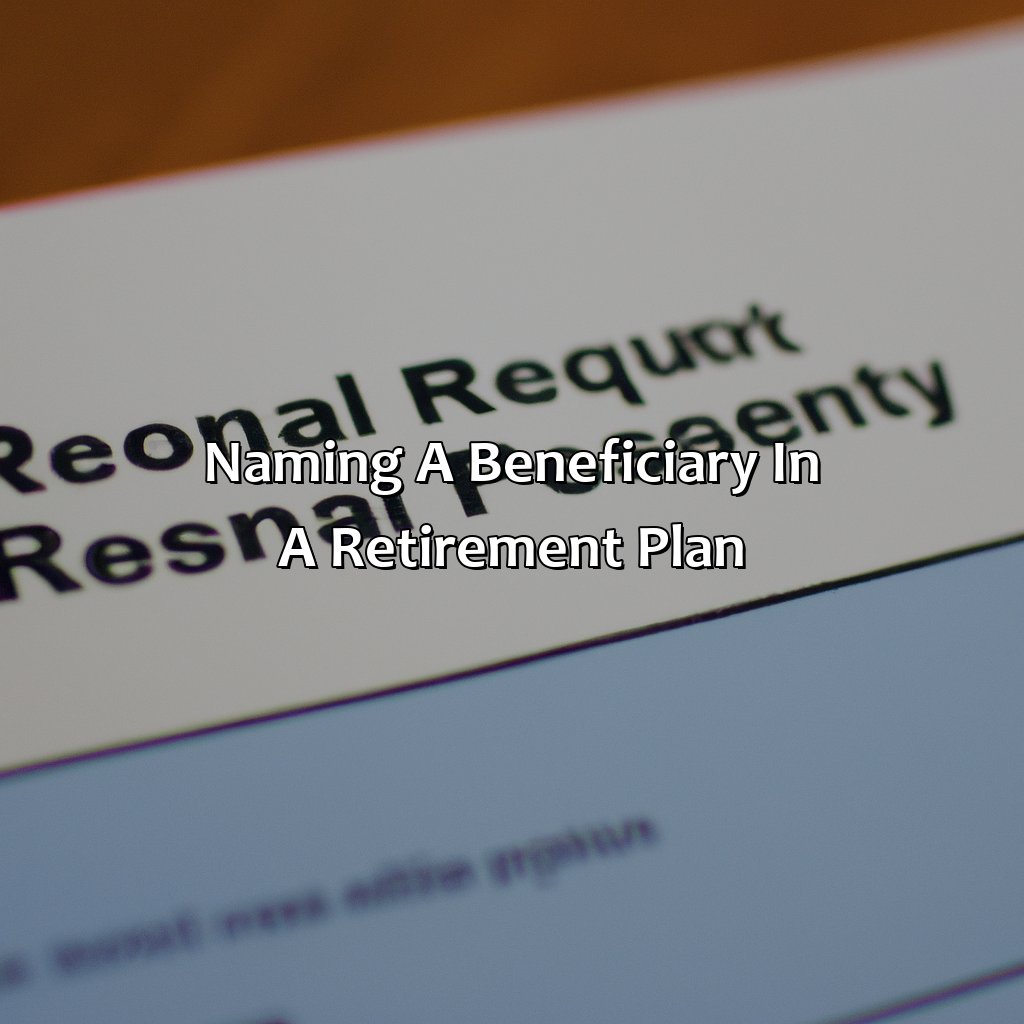What Is A Beneficiary In A Retirement Plan?
Key Takeaways:
- A beneficiary is a person or entity who is designated to receive retirement plan benefits upon the plan participant’s death.
- There are two types of beneficiaries: primary beneficiaries, who are first in line to receive the benefits, and contingent beneficiaries, who receive the benefits if the primary beneficiary is unable to.
- Naming a beneficiary is crucial to ensure that the benefits go to the intended person or entity and to avoid potential legal conflicts and delays.
Does the thought of planning ahead for retirement make you feel overwhelmed? Discover the answer to one of the vital questions- What is a beneficiary in a retirement plan? You, like many others, will now have a better understanding of the key tools necessary to secure your future!
Understanding the Beneficiary in Retirement Plans
When planning for retirement, it is crucial to understand the role of the beneficiary and its importance in financial planning. Naming a beneficiary in a retirement plan means designating one or more individuals or entities to receive the assets of the account upon the account owner’s death. It’s important to ensure that the beneficiary designation is up-to-date and reflects the account owner’s wishes.
A beneficiary in a retirement plan can be a spouse, a child, a family member, a trust or an organization. This choice depends on the account owner’s individual circumstances and their unique financial goals. Updating the beneficiary designation is also necessary if there is a change in the account owner’s personal circumstances such as divorce or birth of a child.
Additionally, the beneficiary designation can impact the distribution of assets in the event of the account owner’s death. If there is no named beneficiary, the account may pass through the will, probate, or other legal processes. This can cause delays, legal fees, and unintended tax consequences.
One famous example of the importance of updating a beneficiary designation is the case of Warren Hillman, a federal employee who forgot to update his beneficiary designation. Following his death, his ex-wife inherited his $124,558 pension benefits instead of his long-term partner, who had cared for him and was listed as a beneficiary in his will.

Image credits: retiregenz.com by David Washington
Definition of a Beneficiary
Beneficiary in a retirement plan refers to the individual who will receive the balance of the account upon the death of the account holder. The beneficiary can be a spouse, child, relative or anyone designated by the account holder. It is important to keep the beneficiary information up to date as it supersedes any will or trust document.
When an account holder passes away, the beneficiary may receive the balance of the account as a lump sum or it can be paid out over several years based on their age. The beneficiary can choose to take distributions as a single payment or in accordance with the required minimum distribution rules.
It is crucial to note that selecting a beneficiary is a personal decision, and it is essential to consider the potential tax and estate planning implications of designating a beneficiary.
Pro Tip: Review and update beneficiary designations regularly to ensure they align with your current wishes and estate plan.

Image credits: retiregenz.com by David Woodhock
Types of Beneficiaries
To get a grip on the types of beneficiaries in a retirement plan, investigate the two pieces: primary and contingent beneficiary. Both are important, but for different reasons. They also have different rules for inheriting assets from the retirement plan.

Image credits: retiregenz.com by Adam Duncun
Primary Beneficiary
The key person entitled to receive the assets of a retirement plan upon the participant’s death is known as the Primary Recipient. The primary beneficiary could be the spouse, children or any other individual of choice upon fulfillment of legal requirements. The allocation of benefits proceeds as per the designated order of precedence following the participant’s wishes, and it can be changed anytime before their death.
Usually, participants designate their spouses as Primary Beneficiaries in retirement plans, enjoying favorable tax options and rollover potentials, though they are not obliged to do so. In most cases, participants also select contingent beneficiaries (secondary) in case anything happens to their first choices.
It is possible for widows or widowers who have remarried but couldn’t change their beneficiary designations earlier to lose their entitlement following decision power resting on the court. They would instead enjoy compensations from alternative products such as annuities.
In an instance where a participant didn’t make a nomination or failed to fulfill legal requirements, then part of retirement benefits goes through probate with shares apportioned among the estate beneficiaries following state-specific probate rules.
If you thought being a backup dancer was tough, try being a contingent beneficiary in a retirement plan.
Contingent Beneficiary
A potential recipient who inherits the retirement plan assets if there are no surviving primary beneficiaries is known as a Backup Beneficiary. Typically, a Contingent Beneficiary is selected to guarantee that assets will go to preferred individuals if Primary Beneficiaries perish or cannot be traced. This guarantees that your heirs receive compensation immediately after you pass on without requiring the intervention of courts.
Contingent Beneficiaries could be a person or an organization, depending on your desires. The priority order of designating beneficiaries will determine who gets what, generally in accordance with state legislation. Review the beneficiary forms (including percentages assigned) regularly to limit problems in processing death benefits when emergencies arise and circumstances change.
Pro Tip: Keep in mind that changing marital status or getting divorced could significantly impact filing procedures and beneficiary designations. Ensure that appropriate arrangements are in place to prevent unintended consequences if these situations arise.
If you really want to make your loved ones happy after you’re gone, just make sure you name them as your retirement plan beneficiary. It’s the gift that keeps on giving… until they kick the bucket too.
Naming a Beneficiary in a Retirement Plan
It’s vital to name a beneficiary for your retirement plan. Understand the importance of this in our section: “Naming a Beneficiary in a Retirement Plan.” We’ll explain the necessity of this, and the need for spousal consent. Knowing this can help you avoid potential conflicts. And make sure your retirement plan gets carried out as intended.

Image credits: retiregenz.com by Adam Jones
Importance of Naming a Beneficiary
Naming a beneficiary in a retirement plan is crucial to ensure that the assets are distributed properly after an individual’s demise. A beneficiary is a person who will receive the assets in case of death.
- It ensures that the assets pass on directly to the desired person avoiding probate.
- It allows individuals to customize their estate plans according to their wishes.
- Avoids conflicts among family members and reduces the risk of court intervention.
- Beneficiary designation supersedes will, trusts, or any other documents relating to asset distribution.
- Failure to name a beneficiary or keep updating it may lead to undesired consequences.
Further, it is essential to review and update the designated beneficiaries periodically for avoiding unintended distributions.
Failing to name proper beneficiaries can cause undesirable outcomes leading loved ones without intended inheritance. Keeping this in mind, naming a beneficiary seems like a simple task but creates significant emotional trauma if overlooked. Make sure you name an appropriate beneficiary in your retirement plan today.
Getting spousal consent for naming a beneficiary in a retirement plan is like trying to convince your partner to watch a rom-com instead of their favorite action movie.
Spousal Consent
When Designating Beneficiary of Retirement Plans: Spousal Consent
Designating a beneficiary on a retirement plan is an important step to ensure that assets are distributed according to your wishes. For married couples, some plans require Spousal Consent. This means that before designating someone else as the beneficiary, the spouse must provide written consent indicating their agreement.
Spousal Consent is required by some plans to protect a surviving spouse’s right to inherit the benefits. In case of death, the surviving spouse would have been entitled to half or all of the benefits. However, if another individual is named as the beneficiary without spousal consent, then they would receive the benefits instead.
It’s important to note that not all retirement plans require spousal consent and each plan has its own rules and regulations. Therefore, it’s crucial to review the plan documents carefully before making any designation decisions.
Pro Tip: Always review and update beneficiaries on retirement plans after significant life events such as marriage, divorce, birth or adoption of children, or death in the family.
“Distributing retirement plan benefits is like a game of hot potato- whoever ends up with the money at the end better be ready to handle it.”
Distribution of Retirement Plan Benefits to a Beneficiary
Retirement Plan Benefits are assets accumulated by contributors over their working years. These assets are distributed to their nominated Beneficiaries upon their death. Beneficiaries are usually a spouse, child or any person nominated by the contributor. Distributions occur according to the rules of the plan, and beneficiaries can choose to receive the funds as a lump sum or series of payments.
When a beneficiary is entitled to the retirement plan benefits, they could receive them in one of two ways. Firstly, as a lump sum, which is the full amount of the asset in one go. Alternatively, payments may be made in a series of payments for a specific period or on a recurring basis. The frequency and nature of the recurring payments will depend on the plan rules and account balance at the time of distribution.
While distribution of retirement plan benefits is a common practice, there are specific rules and regulations to adhere to. Some distributions, for example, may incur tax consequences for beneficiaries. It’s crucial to understand the implications of these distributions for both the beneficiary and the estate and obtain expert advice to ensure legally compliant distribution.
It’s imperative to have a designated Beneficiary in place. In one case, following a Florida man’s fatal car accident on his way home from work, his ex-wife claimed his retirement plan benefits in court. Though he remarried and never updated his beneficiary, his ex-wife, labeled the “default” beneficiary, received the benefits, leaving his wife with nothing.
Therefore, plan contributors must be fully informed of the available options for the distribution of retirement plan benefits to proceed to avoid any unintended and undesirable consequences.

Image credits: retiregenz.com by Harry Jones
Considerations when Naming a Beneficiary
You must look into the subsections below to find the optimal way to name a beneficiary in your retirement plan. Tax effects, estate organizing, and changes to beneficiary designation due to life events: each requires distinct considerations. Being aware of the distinctions will help you make the most knowledgeable choice when naming your beneficiaries.
- Tax effects: This subsection deals with the tax implications of naming a beneficiary in your retirement plan. It is important to understand the tax rules and how they apply to your particular situation.
- Estate organizing: This section focuses on how naming a beneficiary affects your estate plan. It is important to consider your overall estate plan when naming a beneficiary in your retirement plan.
- Changes to beneficiary designation due to life events: This subsection discusses life events that may require you to change your beneficiary designation. Examples of such events include marriage, divorce, the birth or adoption of a child, and the death of a beneficiary.

Image credits: retiregenz.com by James Jones
Tax Implications
When selecting a recipient for your retirement benefits, it’s crucial to consider the taxing consequences related to your choice of beneficiary. By designating a loved one as the beneficiary, you may unintentionally create an unnecessary tax burden.
Depending on various factors such as the amount bequeathed and whether distributions were pre-tax or post-tax, income taxes may apply at the time of distribution. Additionally, if your beneficiary is subjected to estate taxes at their death or requires Medi-Cal assistance, they may become liable for taxes that could have been avoided with proper planning.
It’s important to note that understanding tax implications isn’t as straightforward as one might think. Many variables impact how much money someone will receive after considering all tax requirements and obligations over time.
Crafting a solid will can help guarantee that funds are used judiciously in line with prescribed goals while also avoiding monetary risks like unforeseen expenses or insufficient savings.
Consider this real-life tale of woe: A wealthy individual passes away without creating any designations for their retirement accounts. As a result of this oversight, they lose nearly $2 million in estate taxes due to poorly planned disbursements from these accounts. Don’t let this happen to you! Plan ahead when naming beneficiaries for your hard-earned retirement funds.
If you think estate planning is just for the ultra-rich, you obviously haven’t met my family.
Estate Planning
Managing the inheritance of assets and properties is a crucial task, known as Legacy Planning. This plan includes Estate Planning, which entails anticipating and arranging for the disposal of an individual’s estate in accordance with their wishes while minimizing taxes and legal fees. Naming a beneficiary is a critical aspect of this plan, especially when it comes to retirement plans.
Retirement plans such as 401(k)s, IRAs, and other similar accounts provide benefits to employees or individuals after retirement. Beneficiaries are the persons or entities designated to receive these benefits if something happens to the account owner. While selecting a beneficiary may seem straightforward at first glance, it requires careful consideration regarding family members’ relationships and financial stability.
A considerable aspect while naming beneficiaries for retirement plans is selecting contingent beneficiaries. They only receive benefits in case the primary beneficiary passes away before or with the account owner. Diversifying assets between both primary and secondary beneficiaries will provide additional protection from unexpected events.
Pro Tip: Regularly reviewing named beneficiaries minimizes confusion during stressful times and avoids conflicts among heirs by ensuring financial assets align with an individual’s contingencies and long-term goals.
Updating your beneficiary designation is like updating your relationship status on Facebook, except it’s actually important.
Life Changes and Updates to Beneficiary Designation
Updating Beneficiary Designation after Life Events
Life events, such as marriage, divorce, or the birth of children, may change an individual’s beneficiary designation. Regularly review the listed beneficiaries to ensure they reflect current wishes.
It is crucial to update designations for life insurance policies and other accounts with a beneficiary designation, even when updating a will or trust. Failure to do so could result in a delay in payouts or funds going to unintended heirs.
Consider creating contingency plans for any potential scenario that could affect intended beneficiaries. Consult an attorney or financial planner for advice on how to prepare for such changes.
Did you know that outdated designations can cause disputes which take years to be decided upon in court? Such incidents could have been avoided with updated designations and open communication with loved ones.
Five Key Facts About Beneficiaries in a Retirement Plan:
- ✅ A beneficiary is a person or entity designated to receive the assets in a retirement plan upon the death of the plan participant. (Source: Investopedia)
- ✅ Naming a beneficiary is an important part of estate planning and can help ensure that your assets are distributed according to your wishes. (Source: Fidelity)
- ✅ It is important to review and update your beneficiary designations regularly, especially after major life events such as marriage, divorce, or the birth of a child. (Source: Charles Schwab)
- ✅ In some cases, it may be appropriate to name a trust as the beneficiary of a retirement plan in order to achieve specific estate planning goals. (Source: The Balance)
- ✅ If you do not name a beneficiary for your retirement plan, the assets will generally be distributed according to the default provisions of the plan or state law. (Source: IRS)
FAQs about What Is A Beneficiary In A Retirement Plan?
What is a beneficiary in a retirement plan?
A beneficiary in a retirement plan is a person, entity, or organization designated to receive a retirement account’s assets upon the account owner’s death.
Who can be a beneficiary in a retirement plan?
A beneficiary in a retirement plan can be anyone the account owner chooses, including a spouse, child, friend, or charity. Some retirement plans also allow for multiple beneficiaries.
What happens if a beneficiary predeceases the retirement plan owner?
If a designated beneficiary predeceases the retirement plan owner, the owner can update the beneficiary designation to reflect a new beneficiary or, depending on the terms of the plan, the assets may be distributed according to the plan’s default provisions.
What are the tax implications for a beneficiary in a retirement plan?
The tax implications for a beneficiary in a retirement plan depend on a variety of factors, including the type of account, the age of the account owner at the time of their death, and the beneficiary’s relationship to the account owner. In general, inherited retirement accounts are subject to income tax for the beneficiary.
Can a retirement plan owner change their beneficiary designation?
Yes, retirement plan owners can change their beneficiary designation at any time. It is important to review and update beneficiary designations regularly to ensure that they reflect the current preferences and circumstances of the owner.
What happens if there is no designated beneficiary for a retirement account?
If there is no designated beneficiary for a retirement account, the assets may be distributed according to the plan’s default provisions or the applicable state law. This can result in delayed or unintended distribution of the assets, highlighting the importance of designating a beneficiary.





